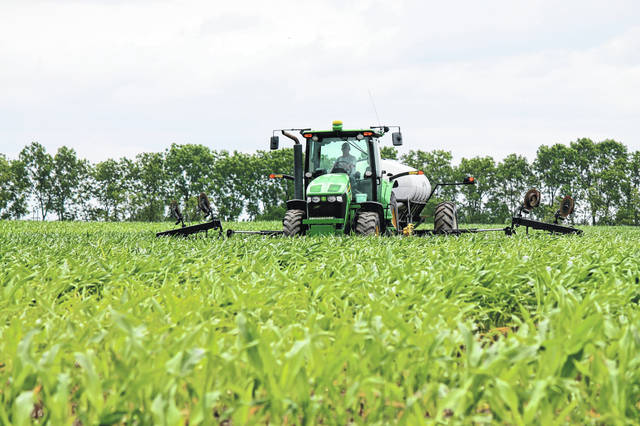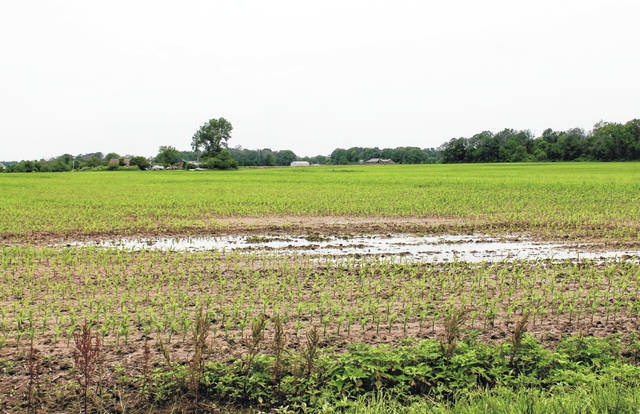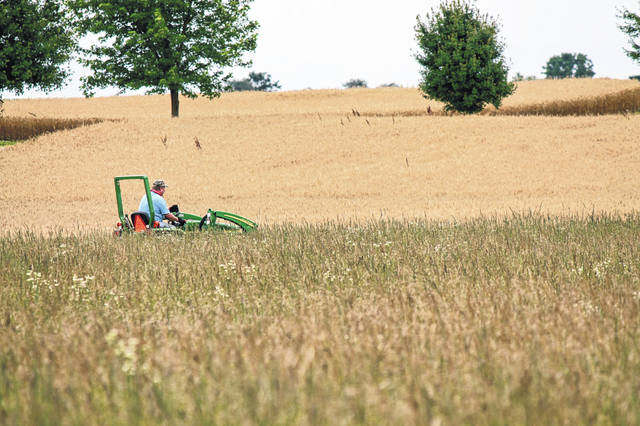


GREENE COUNTY — Greene County farmers can’t remember a year as wet as this.
“I’ve been farming full time since 1985,” Kent Campbell, who farms in Cedarville, said. “We’ve never had a year [like it]. We had a lot of crops we couldn’t get out last fall … We’ve been fighting this wet weather since mid-October.”
Craig Corry, of Xenia, said he’s been farming all his life and couldn’t recall a season quite like this either.
“I can remember way back into the early ’80s — 1981 is maybe a year that veteran farmers will mention as a very wet season, a slow planting season,” he said. “There are many years that are far less than ideal, but the number of years that are ideal conditions outnumber those that are less than ideal.”
But unlike in other Ohio counties, these farmers have their corn and soybeans in the ground, so they’re considering themselves luckier than some.
According to Trevor Corboy, agriculture and natural resources educator for OSU Extension Greene County, at least 90 percent of crops in Greene County have been planted.
“We are fortunate in Greene County as compared to other parts of Ohio,” Corboy said.
Conditions have put local farmers about a month to 45 days behind normal schedule, the farmers reported.
“Wet weather delayed the start of planting season, certainly extended it, and delayed the finish of planting crops,” Corry explained. “Typically this time of year, the first cutting of hay is made, nitrogen fertilizer is applied to the corn, post-emergent application of herbicide on the soybeans. Some places and some people have done some or all of those in small amounts, but there’s still a lot of work yet to be done.”
Campbell said he’s hoping for a break in the rain this week so farmers can get out in the fields.
“We have wheat coming on, probably turning fast, that can be harvested by the end of the week if the weather holds out,” he said.
Besides timing challenges, the rainy weather brings the concern of water damage as well as pest and disease issues.
“Most of the crops that are in the ground right now you want to get out and look at them at least once or twice a week, make sure you don’t have any diseases or anything like that,” Campbell said.
Local feed and seed businesses are having their fair share of challenges, too.
For Campbell, who owns Kent’s Feed Barn in Cedarville, the consistent soggy weather means there’s a shortage in supply of straw and hay, which increases demand.
“It’s probably going to be reflected in prices to the consumer as the year goes out, too,” he explained.
But Corry, who sells Pioneer Seeds, says the true impact on business is yet to be determined.
“If there are any less acres of corn planted in the country, that could set the stage for lower supply this fall, therefore increased prices,” he added.
Ultimately, farmers aren’t sure what will happen next. Harvest will be dependent on growing conditions through the summer and fall.
“Time will tell,” Campbell added. “Now we’re playing the game with how early the frost will come. It takes so many days for a crop to mature. If we can stretch it out and not get an early frost then, why, I think we will definitely have a harvested crop. It’s not going to be near the crop we’ve been raising the last few years.”
Corry said the economic impact is hard to quantify at this point.
“The biggest unknown is what the weather this summer is going to be like,” he said, adding that plenty of moisture with a little bit of sunshine will make up for lost time.
But two to four weeks of extremely hot, dry weather between the Fourth of July and the Greene County Fair could damage young crops in the field.
“That’s when you’ll see stress,” Corry said. “As stressful as the planting conditions this spring have been, there are many factors which are still out of our control that ultimately determine the future of the crop that’s in the ground.”
But, as Campbell says, most farmers have a positive attitude going forward, regardless of conditions.
“Well, we’re gonna survive,” he said. “Farmers are dedicated people. They’re gonna plant a crop and raise a crop. Sometimes it’s not a big crop. But, usually in this area here, there is a crop.”




